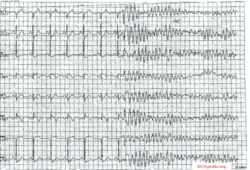Ventricular Fibrillation
Jump to navigation
Jump to search
| This is part of: Ventricular Arrhythmias |
Ventricular fibrillation (VF or V-fib) is chaotic depolarisation of the ventricles. Mechanically this results in an arrested cardiac pump function and immediate death. VF can only be treated by immediate defibrillation. If you consider ventricular fibrillation in a conscious patient, than you should look for a technical problem with the ECG, eg. movement or electrical interference.

